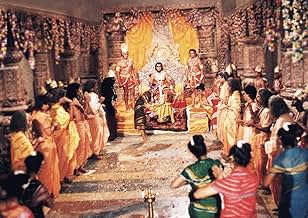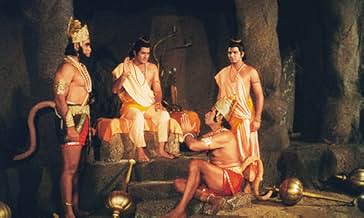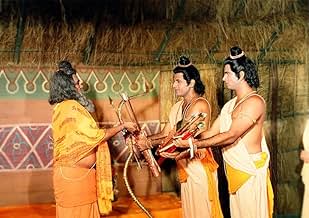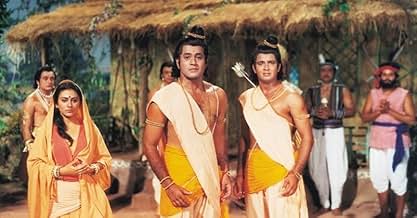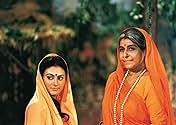Eine Adaption des alten epischen Gedichts, in dem der verbannte Prinz Rama und sein Bruder Laxman aufbrachen, um Ramas Frau Sita zu retten, die vom zehnköpfigen Dämonenkönig Ravana gefangen ... Alles lesenEine Adaption des alten epischen Gedichts, in dem der verbannte Prinz Rama und sein Bruder Laxman aufbrachen, um Ramas Frau Sita zu retten, die vom zehnköpfigen Dämonenkönig Ravana gefangen genommen und eingesperrt wurde.Eine Adaption des alten epischen Gedichts, in dem der verbannte Prinz Rama und sein Bruder Laxman aufbrachen, um Ramas Frau Sita zu retten, die vom zehnköpfigen Dämonenkönig Ravana gefangen genommen und eingesperrt wurde.
- Auszeichnungen
- 1 Gewinn & 1 Nominierung insgesamt
Folgen durchsuchen
Zusammenfassung
Reviewers say 'Ramayan' directed by Ramanand Sagar is celebrated for its faithful adaptation of Hindu mythology, capturing cultural essence and emotional impact. Performances by Arun Govil, Deepika, and Dara Singh are highly commended. Ravindra Jain's music enhances the narrative. Despite criticisms of production values and special effects, the series is lauded for its cultural significance and profound societal impact during its original airing.
Empfohlene Bewertungen
10DrEbert
When "Ramayan" aired, India (even then having a population over 900 million) came to a standstill. Buses stopped running, religious services (Hindu and non-Hindu) were rescheduled, and everyone stopped what they were doing for 30 minutes every Sunday morning to watch the ancient Indian epic brought to life on television. It's hard to believe that something like that is possible, but it really happened. Despite being dismissed by some as a cheap production with garish sets, cheesy special effects, and melodramatic dialogue, "Ramayan" was and continues to be a phenomenon.
True, the production is quite obviously very low budget and it shows in the special effects and sets. (Tollywood director Bapu's "Seeta Kalyanam" a.k.a. "Seeta Swayamvar" shows a much better production, even though it, too, was low-budget.) Some of the same actors are used repeatedly for various minor roles and voices. At times, it does look like a high school production.
But, what Ramanand Sagar (who, in my opinion, is otherwise a mediocre filmmaker) has done here is spectacular. Despite all of the above, "Ramayan" works incredibly well because one can sense that a great deal of devotion went into making it. This is a series that really has a heart and soul. Every time I watch "Ramayan," I have a religious experience.
The dialogue might sound melodramatic to some (and sometimes it is), but the script is extremely faithful to the original texts that it is based off of. Sometimes, lines are directly quoted from Valmiki or Tulsidas and translated into Hindi. "Ramayan" takes very little dramatic license and so what is presented on screen is an accurate presentation of the source texts. This gives "Ramayan" value not only to devout Hindus but also to students of Hindu religion and Indian epic poetry, both of whom can watch the series and get a good understanding of the works of Valmiki, Tulsidas, and others. The feeling conveyed in the television series is the feeling conveyed from a recital of the epic itself.
What also helps this series tremendously is the music by Ravindra Jain. Indian storytelling in general (both in film and in religious sermons) has a tradition of mixing dialogue with songs. Here, Ravindra Jain uses music to its fullest advantage. There are plenty of songs throughout the series, but they are placed in perfect situations. This is not the typical Bollywood style of breaking into song and dance at random and inappropriate places. Instead, rather than boring the audience with a long battle scene filled with cheap special effects, the battle is shown with a song describing the battle. Scenes of devotion naturally have devotional music with them. Transition scenes are accompanied by lines of Tulsidas. In fact, Jain sometimes cleverly and seamlessly merges his own lyrics with the poetry of Tulsidas, creating songs that are modern masterpieces of music.
I'm generally satisfied with the casting choices. Arun Govil and Deepika do well as Rama and Sita. Dara Singh is not an incredibly talented actor (he is originally a wrestler), but it worked for me to have him as Hanuman. My three favorite performances, though, are Sunil Lahri as Lakshmana (he's got Lakshmana's angry look down perfectly), Vijay Arora as Indrajit (he's got the boisterous personality down), and veteran character actress Lalita Pawar as Manthara (a perfect choice, as Pawar made a career out of playing literally hundreds of Manthara-like characters). Arvind Trivedi is not bad as Ravana, but he does not have the physically dominating presence that Ravana would need to have. Ravana should be tall, dark, muscular, and handsome, and Trivedi is none of those things. Still, not a bad performance on his part. (As an aside, the single worst casting choice is the actor picked to play Parshurama in one episode early on in the series; they picked somebody less than 5 feet tall to play a domineering character and it completely doesn't work.)
We tend to put all of that aside, though, because of just how well the story works for us. "Ramayan" made religion fashionable on Indian television. This is why some scholars list Ramanand Sagar (who, I reiterate, was an otherwise mediocre filmmaker) as one of 4 men (along with Valmiki, Tulsidas, and Kamban) who has shaped modern interpretations of the Ramayana story. That is quite an achievement, to be one of the four main forces that guide a tradition that dates back thousands of years, all on a budget (I'm told) of Rs. 100,000 per episode.
Really, I've already said more than needs to be said. All that really needs to be said is that "Ramayan" brought India to a STANDSTILL!
True, the production is quite obviously very low budget and it shows in the special effects and sets. (Tollywood director Bapu's "Seeta Kalyanam" a.k.a. "Seeta Swayamvar" shows a much better production, even though it, too, was low-budget.) Some of the same actors are used repeatedly for various minor roles and voices. At times, it does look like a high school production.
But, what Ramanand Sagar (who, in my opinion, is otherwise a mediocre filmmaker) has done here is spectacular. Despite all of the above, "Ramayan" works incredibly well because one can sense that a great deal of devotion went into making it. This is a series that really has a heart and soul. Every time I watch "Ramayan," I have a religious experience.
The dialogue might sound melodramatic to some (and sometimes it is), but the script is extremely faithful to the original texts that it is based off of. Sometimes, lines are directly quoted from Valmiki or Tulsidas and translated into Hindi. "Ramayan" takes very little dramatic license and so what is presented on screen is an accurate presentation of the source texts. This gives "Ramayan" value not only to devout Hindus but also to students of Hindu religion and Indian epic poetry, both of whom can watch the series and get a good understanding of the works of Valmiki, Tulsidas, and others. The feeling conveyed in the television series is the feeling conveyed from a recital of the epic itself.
What also helps this series tremendously is the music by Ravindra Jain. Indian storytelling in general (both in film and in religious sermons) has a tradition of mixing dialogue with songs. Here, Ravindra Jain uses music to its fullest advantage. There are plenty of songs throughout the series, but they are placed in perfect situations. This is not the typical Bollywood style of breaking into song and dance at random and inappropriate places. Instead, rather than boring the audience with a long battle scene filled with cheap special effects, the battle is shown with a song describing the battle. Scenes of devotion naturally have devotional music with them. Transition scenes are accompanied by lines of Tulsidas. In fact, Jain sometimes cleverly and seamlessly merges his own lyrics with the poetry of Tulsidas, creating songs that are modern masterpieces of music.
I'm generally satisfied with the casting choices. Arun Govil and Deepika do well as Rama and Sita. Dara Singh is not an incredibly talented actor (he is originally a wrestler), but it worked for me to have him as Hanuman. My three favorite performances, though, are Sunil Lahri as Lakshmana (he's got Lakshmana's angry look down perfectly), Vijay Arora as Indrajit (he's got the boisterous personality down), and veteran character actress Lalita Pawar as Manthara (a perfect choice, as Pawar made a career out of playing literally hundreds of Manthara-like characters). Arvind Trivedi is not bad as Ravana, but he does not have the physically dominating presence that Ravana would need to have. Ravana should be tall, dark, muscular, and handsome, and Trivedi is none of those things. Still, not a bad performance on his part. (As an aside, the single worst casting choice is the actor picked to play Parshurama in one episode early on in the series; they picked somebody less than 5 feet tall to play a domineering character and it completely doesn't work.)
We tend to put all of that aside, though, because of just how well the story works for us. "Ramayan" made religion fashionable on Indian television. This is why some scholars list Ramanand Sagar (who, I reiterate, was an otherwise mediocre filmmaker) as one of 4 men (along with Valmiki, Tulsidas, and Kamban) who has shaped modern interpretations of the Ramayana story. That is quite an achievement, to be one of the four main forces that guide a tradition that dates back thousands of years, all on a budget (I'm told) of Rs. 100,000 per episode.
Really, I've already said more than needs to be said. All that really needs to be said is that "Ramayan" brought India to a STANDSTILL!
The re telecast of this series certainly once again affirms the belief that this show is a truly an amazing creation with a perfect blend of acting, screenplay, music. The verses from Ramcharitamanas have also been used at the most suitable points.It will continue to hold the title of best Ramayan ever adapted on screen
We used to sit with family and watch now this serial started again in the lock down of india and same we are sitting and watching, what a lovely moment. Coming to ramcharitmanas version, many tried to do but this never created again. All character are masterpiece. Thanks to ramanand sagar and team
Sagar's original Ramayana was literally brilliant. The show had ensemble cast. Everyone just nailed it in their respective roles. But my favorite performance was Sunil Lahri's performance as Lakshman. I think no one has given such an impressive performance in Laxman's character till date. What can I say about Arvind Trivedi's performance as Ravana? He just nailed it. Arun Govil and Dipika will remain Godly figures for people. But above all big thanks to late Ramanand Sagarji for creating this Gold.
Doesn't matter how many versions of Ramayana will come but this Ramayan will remain Gold. If you are fan of Mythological/Devotional shows than you will never get bored of watching Sagar's Ramayan and B.R. Chopra's Mahabharat.
Doesn't matter how many versions of Ramayana will come but this Ramayan will remain Gold. If you are fan of Mythological/Devotional shows than you will never get bored of watching Sagar's Ramayan and B.R. Chopra's Mahabharat.
Childhood memories: other children found it boring, I watched it with thirst along with my family.
There was hardly any episode i missed.
It stayed true to its time.
Although waiting for a brand new make.
There was hardly any episode i missed.
It stayed true to its time.
Although waiting for a brand new make.
Wusstest du schon
- WissenswertesAfter being initially rejected by Doordarshan due to perceived lack of interest in religious programming, the series quickly went on to become the most popular series in Indian television history, reaching over 100 million viewers each week. Its popularity reached a point of what the Indian news magazine India Today called "'Ramayan' fever", where religious services were rescheduled, buses, trains, and inter-city trucks were stopped, and shops would close every Sunday at 9:30 a.m. so that people would gather to watch the show. In villages, watching the show became a religious ritual unto itself. The show's popularity would remain the highest in history until a few years later, when Mahabharat (1988), also based on an ancient Hindu epic, would exceed its popularity.
- Alternative VersionenAfter the sequel series Luv Kush (1988) ended, both the series were aired combined as "Sampurna Ramayan".
- VerbindungenFeatured in Shri Krishna (1993)
Top-Auswahl
Melde dich zum Bewerten an und greife auf die Watchlist für personalisierte Empfehlungen zu.
- How many seasons does Ramayan have?Powered by Alexa
Details
- Laufzeit30 Minuten
- Farbe
- Seitenverhältnis
- 4:3
Zu dieser Seite beitragen
Bearbeitung vorschlagen oder fehlenden Inhalt hinzufügen



